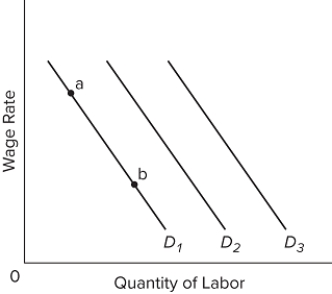B) False
Correct Answer

verified
Correct Answer
verified
True/False
If the demand for a product produced by an input decreases, the demand for the input will also decrease.
B) False
Correct Answer

verified
Correct Answer
verified
Multiple Choice
Other things being equal, how would the market for tablet computers be affected by a large increase in productivity in the tablet-computer industry?
A) a decrease in price and a leftward movement along the supply curve
B) a decrease in price and a rightward movement along the demand curve
C) a decrease in price and a rightward movement along the supply curve
D) an increase in price and a rightward movement along the demand curve
F) B) and D)
Correct Answer

verified
Correct Answer
verified
Multiple Choice
 Refer to the graph. Each of the three labor demand curves shown slopes downward because of the
Refer to the graph. Each of the three labor demand curves shown slopes downward because of the
A) law of diminishing marginal utility.
B) law of increasing opportunity costs.
C) principal-agent problem.
D) law of diminishing returns.
F) A) and C)
Correct Answer

verified
Correct Answer
verified
True/False
If two resources are complementary, an increase in the price of one will increase the demand for the other.
B) False
Correct Answer

verified
Correct Answer
verified
Multiple Choice
A firm is producing with the least-cost combination of resources when the
A) last dollar spent on each resource yields the same marginal product.
B) total dollars spent on each resource are all the same.
C) unit prices of the resources are equalized.
D) marginal product of each of the resources is all the same.
F) None of the above
Correct Answer

verified
Correct Answer
verified
Multiple Choice
Harry owns a barbershop and charges $6 per haircut. By hiring one barber at $10 per hour, the shop can provide 24 haircuts per eight-hour day. By hiring a second barber at the same wage rate, the shop can now provide a total of 42 haircuts per day. The MP of the second barber is
A) $240.
B) $108.
C) 18 haircuts.
D) 42 haircuts.
F) A) and C)
Correct Answer

verified
Correct Answer
verified
Multiple Choice
Suppose that the production of wheat requires two inputs, labor and fertilizer. The price of labor is $4.50, and the price of fertilizer is $3.00. A farmer is currently employing the inputs such that the marginal product of labor is 11 and the marginal product of fertilizer is 8. If the farmer is a cost-minimizer, he should
A) use more labor and less fertilizer.
B) use more fertilizer and less labor.
C) use more labor and more fertilizer.
D) continue using the same amounts of each input.
F) All of the above
Correct Answer

verified
Correct Answer
verified
Multiple Choice
 The table shows a total-product schedule for a resource. Assume that the quantities of other resources the firm employs remain constant. If the firm can sell 24 units of output at a price of $1.00 and 42 units of output at a price of $0.80, the marginal revenue product of the second unit of the resource is
The table shows a total-product schedule for a resource. Assume that the quantities of other resources the firm employs remain constant. If the firm can sell 24 units of output at a price of $1.00 and 42 units of output at a price of $0.80, the marginal revenue product of the second unit of the resource is
A) $5.40.
B) $7.80.
C) $9.60.
D) $12.20.
F) A) and D)
Correct Answer

verified
Correct Answer
verified
Multiple Choice
If technology dictates that labor and capital must be used in fixed proportions, an increase in the price of capital will cause a firm to use
A) more labor as a consequence of the substitution effect.
B) more labor as a consequence of the output effect.
C) less labor as a consequence of the substitution effect.
D) less labor as a consequence of the output effect.
F) A) and C)
Correct Answer

verified
Correct Answer
verified
Multiple Choice
If the price of capital declines, the consequent output effect would be
A) greater, the more elastic the demand for the product.
B) greater, the less elastic the demand for the product.
C) negative.
D) of consequence only if capital and labor are used in fixed proportions.
F) B) and D)
Correct Answer

verified
Correct Answer
verified
True/False
The marginal revenue product curve of a purely competitive seller declines solely because of the law of diminishing returns.
B) False
Correct Answer

verified
Correct Answer
verified
Multiple Choice
 The table shows the total output a firm will be able to produce if it employs varying amounts of resource X while holding the amounts of the other resources constant. Assume that the product price is constant at $3.00 per unit. How many units of resource X will be employed if its price is $24 per unit?
The table shows the total output a firm will be able to produce if it employs varying amounts of resource X while holding the amounts of the other resources constant. Assume that the product price is constant at $3.00 per unit. How many units of resource X will be employed if its price is $24 per unit?
A) 3
B) 4
C) 5
D) 6
F) B) and C)
Correct Answer

verified
Correct Answer
verified
Multiple Choice
 Refer to the given data. This firm is selling its product in
Refer to the given data. This firm is selling its product in
A) an imperfectly competitive market at prices that decline as sales increase.
B) a purely competitive market at $3 per unit.
C) a purely competitive market at $2 per unit.
D) an imperfectly competitive market at $3 per unit.
F) A) and B)
Correct Answer

verified
Correct Answer
verified
Multiple Choice
The purely competitive employer of resource A will maximize the profits from A by equating the
A) price of A with the MRP of A.
B) marginal productivity of A with the MRC of A.
C) marginal productivity of A with the price of A.
D) price of A with the MRC of A.
F) All of the above
Correct Answer

verified
Correct Answer
verified
Multiple Choice
 Refer to the given data. For the $12 to $10 range of wage rates, labor demand is
Refer to the given data. For the $12 to $10 range of wage rates, labor demand is
A) perfectly elastic.
B) inelastic.
C) unit elastic.
D) elastic.
F) A) and B)
Correct Answer

verified
Correct Answer
verified
Multiple Choice
In a given labor market, the demand for labor by employers will shift to the right or left with changes in all of the following, except
A) the demand for the products produced by the employers.
B) the price of labor that the employers must pay.
C) the prices of other resources that the firms must use.
D) occupational trends affecting the particular labor in the market.
F) A) and B)
Correct Answer

verified
Correct Answer
verified
True/False
The marginal revenue product of labor is measured in dollars per unit of labor.
B) False
Correct Answer

verified
Correct Answer
verified
Multiple Choice
What happens when technological advance makes available a new highly productive capital good for which MP/P is greater than that of labor for which it is a substitute resource?
A) Labor will replace the new capital because labor is now cheaper.
B) The new capital will replace labor because it reduces the firms' costs.
C) More of both the new capital and labor will be used because firms are more productive.
D) Less of both the new capital and labor will be used because the firms do not know how to use the new technology.
F) None of the above
Correct Answer

verified
Correct Answer
verified
True/False
Marginal revenue product (MRP)is the change in total product (total output)associated with hiring an additional unit of labor.
B) False
Correct Answer

verified
Correct Answer
verified
Showing 161 - 180 of 359
Related Exams